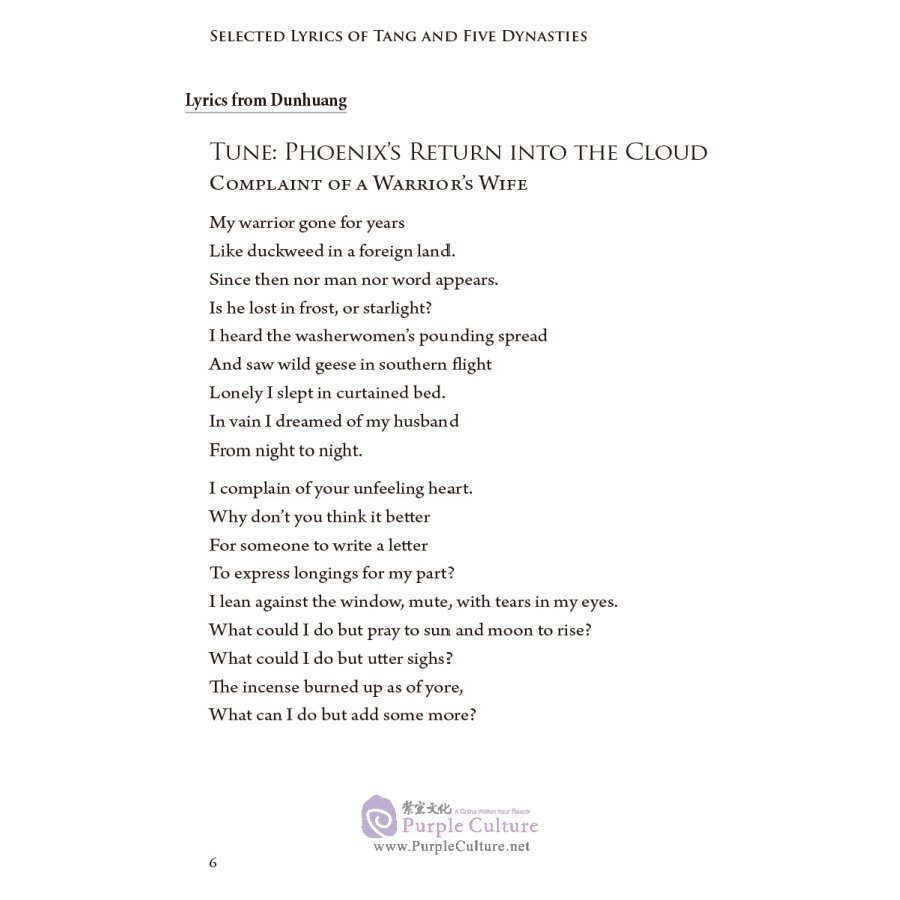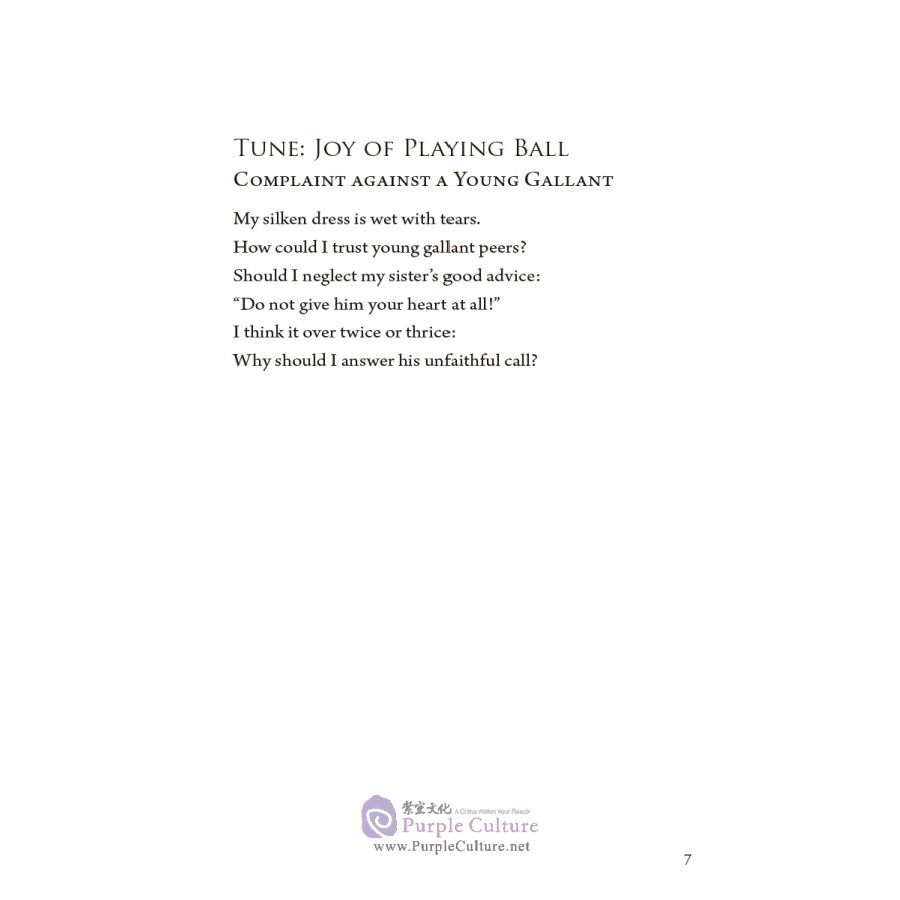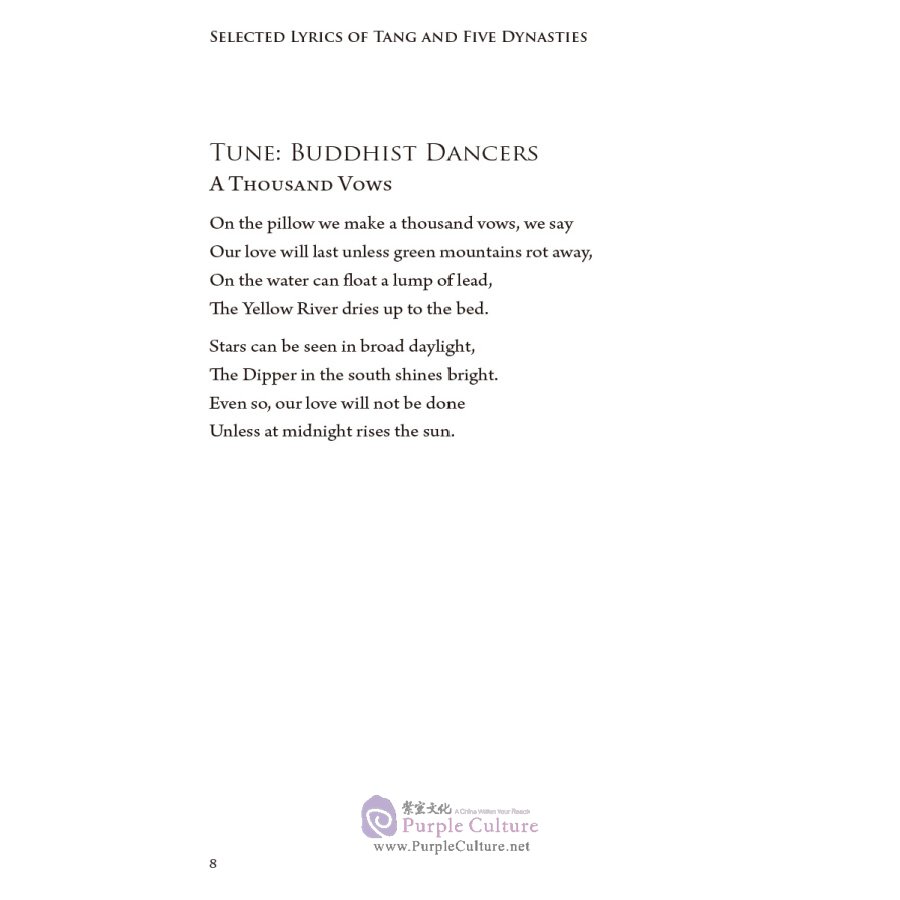Sample Pages Preview


 Preface
Preface
序
《中国词选》罗马尼亚译者说:“中国词使我们认识了一个无容置疑的充满魅力、抒情性强和意境深邃的世界,在这个世界里洋溢着书面上看到的花朵的香气”,中国的词“是三干多年悠久文化与文明的结晶”。
中国词的兴起,可以追溯到隋代。著名的《河传》、《柳枝》就是当时的民歌,《水调》也是开凿运河的产物。到了唐代,词有了新的发展。1900年在敦煌发现的唐人曲词残卷,共有1160余首,其中多数来自民间,有鲜明的性格特征和浓厚的生活气息,如《菩萨蛮》:
枕前发尽千般愿:要休且待青山烂。
水面上秤锤浮,直待黄河彻底枯。
白日参辰现,北斗回南面。
休即未能休,且待三更见日头。
这首词写爱情的盟誓,充满了坚贞的信念,火一样的热情,新颖泼辣,奇特生动。就形式而言,第三句中的“上”字和第四句、第八句中的“直待”、“且待”,都是衬字。如果把衬字取消,形式就和其他《菩萨蛮》的曲调一致了。此外,《菩萨蛮》的调名也说明了佛教对唐代文化的影响。
这本词集里选了一些唐代民间词,《鹊踏枝》通过妇人和灵鹊的对话,写出了妇人对和平幸福生活的热烈向往,表现手法相当新颖灵活,语言也活泼生动。此外,《鹊踏枝》的调名也说明了,词的内容和调名最初是有关系的。
文人词里最早的作品,据传是李白的《菩萨蛮》和《忆秦娥》,但也有人认为这两首词都是后来无名词人写的。《菩萨蛮》一词据说“写在鼎州沧水驿楼”,“解者或依此,以为既写在驿楼,当即在驿楼中所作。既驿楼中作,当即为男子自己抒怀乡之情,故定此词的主人公是男子”。但是靳极苍说:“就词本身来看,还是解作闺情,定主人公为怀远盼归的少妇为好。”我在这里译成“闺情”。
《忆秦娥》一词,靳极苍说:“作者借秦娥的忆旧,以抒发自己伤逝的感情。”李汉超却在《论李白<忆秦娥>》一文中说:“年年伤别”,“实指徭戍行人”,因此认为这词是“一首以天宝之乱为背景、充满政治激情的反映唐代由盛转衰的伤时之作。”加上《忆秦娥》的调名与词的内容有关,可能是最初的作品,因此他认为这词不是后人伪作。我觉得他的话很有道理,也在英文注中作了说明。
Preface
The word “lyric” used in this anthology refers to a poem composed to a certain tune. During the Tang Dynasty (618–907), the subject matter of a lyric often corresponded to the meaning of its tune title. For example, the Magpie on the Branch, a popular song selected here, deals with a magpie in the cage; the Dream of a Maid of Honour, the first literary lyric attributed to Li Bai, depicts the solitude of a young woman waking from the dream of her husband; Zhang Zhihe’s A Fisherman’s Song describes the happiness of a fisherman; Bai Juyi’s Everlasting Longing depicts the longing of a young wife for the return of her husband; Liu Yuxi’s Ripples Sifting Sand deals with the women washing gold from sand; Huangfu Song’s The South Recalled reveals the poet’s nostalgia for the Southern Country. Since the Late Tang, the subject of the lyric had gradually lost its thematic connection with the tune pattern.
In 1900, in a Buddhist monastery of Dunhuang were found the hand-copied manuscripts of over a thousand lyrics and songs which had been sealed and preserved there for almost a thousand years. Among the manuscripts we find a considerable number of popular songs that may be dated back to the Early Tang (c. 650) and that were sung during the Tang and Five Dynasties (907?960) period. Originally the lyric was considered a popular song form. The differences between a literary lyric and a popular song are as follows: (1) The former is characterized almost exclusively by the lyrical mode while the latter contains a variety of modes-narrative, dramatic and lyrical. For example, in the first popular song selected in this anthology, a dialogue is used to heighten the effect of dramatic action. (2) A popular song states feelings in a straightforward manner, simple and direct, while a literary lyric is subtle and refined. (3) The diction of the former is generally closer to the spoken, colloquial usage while that of the latter is literary.
Popular songs were composed by unknown poets or common people and sung by courtesans and musicians. The first literate who began to write lyrics was supposed to be Li Bai (701–762), whose two poems collected here deal with the sorrow of farewell and separation. Some scholars claimed that the Buddhist Dancers attributed to him was forgery for, in their view, that tune could not have been produced as early as the High Tang (c. 713–755). In fact, it was proved that in 742 a certain monk of Longxing Temple composed a song to the tune of Buddhist Dancers, which was found in the Thousand Buddha Caves at Dunhuang and is now preserved in the British Museum.
At first, the literary lyric was based on the poetics of the seven charactered quatrain, which could be set to music during the High Tang. The favorite tunes among the literati poets of the Middle Tang were those whose song words were written in exactly the same pattern as the seven-charactered quatrain, for example, Bai Juyi’s and Liu Yuxi’s Bamboo Branch Song and Willow Branch Song. Gradually some popular tunes changed into different metrical patterns, for instance, Liu Yuxi’s and Li Yu’s Ripples Sifting Sand. The contribution of literati poets to the lyric is that, while the persona in popular songs often starts by expressing a particular feeling explicitly and then dwells on it throughout the poem, the literati poets combine carefully the persona’s inner feeling and natural scenes to form a world of correspondence.


